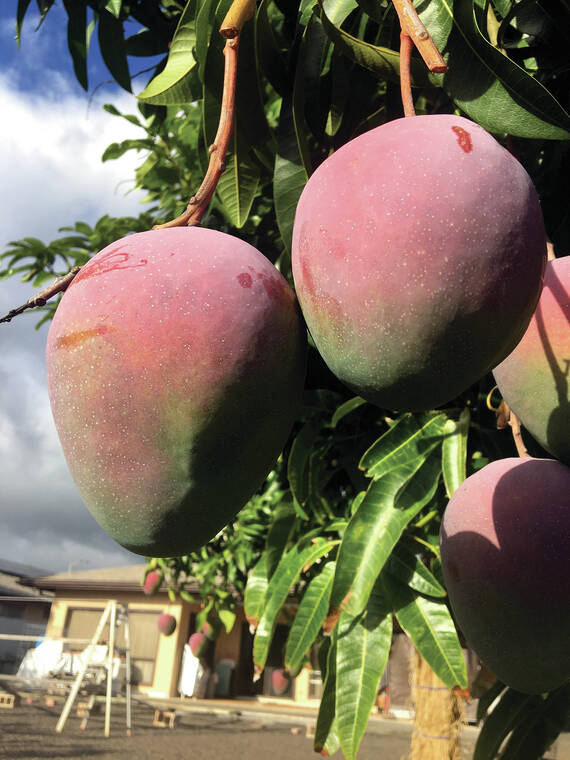Let’s Talk Food: Mangoes are in season

Photo courtesy Audrey Wilson Rapoza mangoes.
Mangoes are in season now and we are enjoying the sweet, juicy, large ones now available at the market. (Not to mention expensive too — you just have to pay it with the other groceries and not look at the price.)
Mangoes are in season now and we are enjoying the sweet, juicy, large ones now available at the market. (Not to mention expensive too — you just have to pay it with the other groceries and not look at the price.)
There are many varieties to choose from and Plant It Hawaii, our local source for trees, has many varieties, with this advice: “Mangoes grow best in areas with 40-60 inches of rain annually.”
ADVERTISING
Wow, that means we have to plant them in Kona!
Brook’s Late: This variety is from Florida and bears fruit from August into October. Trees are medium sized and vigorous. Flesh is sweet and mild, thin seed and green skin when ripe. This mango can be grown successfully in the windward and leeward side of the island. The skin is golden yellow, and fruits weigh between 10 to 16 ounces. This variety is resistant to anthracnose and tree growth is dense and compact.
Exel: This tree bears fruit in July and August and weighs in at one pound with very little fiber and a very thin seed. This one won’t grow in Hilo as it should be planted in dry areas only.
Fairchild: Another variety from Florida, it bears fruit in June and July. Fruits are smaller, at 6 to 8 ounces, flesh is juicy, low in fiber, sweet and rich with a yellow-green skin when ripe. This variety tolerates wetter climates and is anthracnose tolerant.
Florigon: This variety is a large and vigorous grower with yellow fruits, with excellent flavors and large, 10 to 16 ounces. Florigon produces fruit between May and July and is anthracnose resistant.
Glenn: “Glenn is a ‘Haden’ seedling selection from Florida, it is a small to medium size tree that regularly bears 16 ounce, low fiber, spicy, rich flavored fruits.” This bears fruit from May to July and is resistant to anthracnose.
Golden Glow: This variety is from Kihei Maui and bears fruit in May through June. The mangoes are huge, weighing in at 20 to 24 ounces, with little fiber, thin seed and great flavor. Best grown in dry places only.
Haden: This variety has been around for a long time and used to be the only large mango available. Fruits are harvested between July and July, with fruit between 16 to 24 ounces. Trees are vigorous and generally bear fruit every other year. Hadens don’t like too much rain and do best in dry areas only.
Julie: Julie is a dwarf tree from North Africa, with smaller fruits weighing in at 6 to 10 ounces. The fruit is fiberless, smooth and delicious and the skin is yellow with a red blush. This also won’t grow in Hilo as it likes dry areas only.
Keitt: Keitt is an abundant bearer of huge, 2 to 4 pound mangoes. Fruits come out from August to October. Flesh is sweet with low fiber, thin seed and skin of purple or red blush. This fruit has a long shelf life.
Nam Doc Mai: This variety is from Thailand and fruits from June till July. The mango is slender with a thick, greenish-yellow skin, flesh is fiberless, very sweet and juicy. It can be eaten green. This is another that fruits every other year. You can grow this one in Hilo as it likes wetter weather.
Pope: This variety is a heavy bearer with high quality fruit. When ready to eat, its skin turns yellow and red. It can be harvested in July and August, with nice mangoes weighing in at 10 to 18 ounces. Unfortunately, it likes dry areas.
R2E2: This smooth skinned, golden mango with a red blush, has a small seed. It bears fruit 16 to 24 ounces with flesh that is rich, melting, and spicy with no fiber. This one also likes dry weather.
Rapoza: This variety was developed by the Department of Horticulture at the University of Hawaii at Manoa and named in honor of Herbert Rapoza, one of the dedicated individuals employed at the Poamoho Experiment Farm. It is a heavy producer with excellent fruit, ranging from 15 to 30 ounces. When ripe, the skin is yellow with a red or purple blush, with a thin seed. The flesh is fiberless and bears annually in July through August.
Gouveia: This variety is a Pirie seedling from Oahu that regularly bears in August. Flesh is sweet, fiberless, and averages at 16 to 24 ounces. It likes dry areas.
Mapulehu/Joe Welsh: This is from Molokai and weighs in at 26 to 20 ounces. It is one of my favorite mango varieties as it is juicy, delicious, with no fiber. It has a little “nose” at the end so you can easily identify it. It bears fruit in July and likes the dry weather of Kona.
Pirie: This mango bears fruit every other year, has fiberless, sweet flesh. Pirie likes dry weather.
White Pirie: This is an older variety with 8 to 12 ounce fruits, liking dry areas.
Which of these varieties of mangoes will you get to eat this season?
Email Audrey Wilson at audreywilson808@gmail.com.


